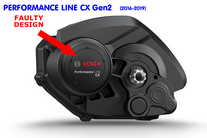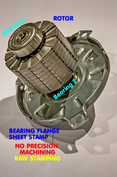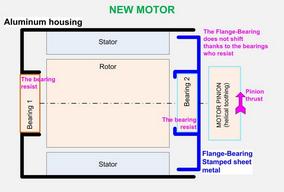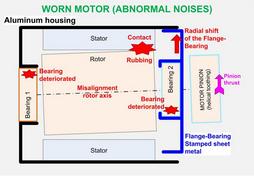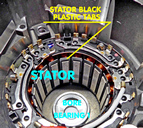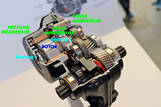


| < - > Bike — Sitting — Be heard — Push-back — Shield-oneself — Transport — Trailer — GPS — Drink — Camping — Energy |
| . . . Conventional Bike (Quality) — E.Bike Quality) 2019 — E.Bike Quality) 2024 — Gearbox ROHLOFF — BOSCH motor |
BOSCH MOTOR PERFORMANCE LINE CX Generation 2
In 2019 we bought 2 E.Bike HOMAGE from Riese & Müller, with which we rode from 2019 to 2022.
These bikes were equipped with BOSCH PERFORMANCE LINE CX Gen2 (Generation 2) engines. These engines were produced from 2016 to 2019.
We have had to suffer a considerable number of failures and therefore replacements of these engines. SeeHERE THE SEQUENCE OF THESE PROBLEMS.
That led us to a dispute. To support our case, I dissected and completely analyzed an engine and wrote a technical report.
The following is a simplified excerpt from this report.
PREAMBLE
From 2019 to 2023, during the multiple defects of our BOSCH PERFORMANCE LINE CX Gen2 engines, I made audio recordings of engine sound effects emitted during taxiing.
TECHNICAL ANALYSIS - ASSUMPTIONS
Listening to all the sounds makes it possible to realize that when you turn the pedals at very low speed, the noise is immediately emitted at high frequency. The noise is therefore emitted by an organ that already rotates quickly.
The gear train of the engine block starts in the ascending direction (from the crankset to the electric motor) with a succession of chainrings (many teeth) and pinions (low number of teeth).
This makes sense since it allows the engine to run at a high starting speed, compatible with the physics of rotating electromagnetic fields:
- The pedalboard is the organ that turns the most « slowly », according to the rate desired by the cyclist.
- The engine is the organ that turns the most « fast », in proportion to the speed imposed by the pedal
The entire gear train AND the electric motor run continuously as soon as the cyclist pedals:
- Without any mechanical force between the electric motor and the crankset if the degree of assistance is 0%.
- With a torque transmitted by the electric motor to the final crank shaft if the assistance regulation is in demand.
The high frequency of noise (at low crank speed) suggests that the origin is in the electric motor:
- Since this is the fastest part
- And that only the electric motor has parts that must be as close as possible to each other: the rotor and the stator. For efficient management of the electromagnetic flux there must be a small distance between the outer diameter of the rotor and the inner diameter of the stator.
The views of the engine block, lid removed, show:
- That starting from the bottom bracket each stage of the gear tray is held in place (guided):
- D’un coté dans un usinage (alésage) précis du carter moteur en aluminium.
- De l’autre côté dans un usinage (alésage) précis du capot-couvercle en aluminium.
- That on the final stage, the rotor shaft of the electric motor is guided:
- On one side by a precisely adjusted bearing in a machining (bore) of the aluminum crankcase.
- On the other by a simple BEARING FLANGE STAMPED SHEET.
The Bearing-Flange is secured to the crankcase by 3 legs of the Stamped Sheet. Each lug has a hole for the fixing screws to pass through the crankcase.
It can be seen:
- That no precision machining exists on the Stamped Sheet for its placement and attachment.
- That this could allow a RADIAL SHIFT by sliding the Bearing-Flange under the pushing force between the electric motor output pinion and the next gear plate.
This could result in a radial shift of the rotor bearing 2. In this case, there would be a misalignment between the rotor and the stator, and the rotor would move towards the stator… until it touched and rubbed?
ROTOR BALANCE STATIC ANALYSIS:
- EXPECTED FORCES: Normally the rotor is designed as a beam balanced on 2 supports:
- Bearing 1 is designed to withstand a pure radial force (related to the radial reaction force of the pinion)
- Bearing 2 is designed to withstand a radial force PLUS an AXIAL force (related to the oblique toothing of the pinion).
- UNPLANNED ACTUAL FORCES: Under the abnormal and repeated stress, related to the sliding of the Bearing-Flange, the bearings 1 and 2 are subjected to an UNEXPECTED TORQUE (not foreseen during the design). This DETERIORATES THE BEARINGS.


In balance of forces,
FPS (fundamental principle of statics)
indicates that the sum of the forces is zero,
just as the sum of the moments is zero.
CONSEQUENCES - ENVISAGED CHRONOLOGY
- NEW MOTOR: Rotor Bearings 1 and 2 are new. Whether ball or roller, they fully withstand the radial thrust forces of the pinion.
- MOTOR WITH MILEAGE: Under the abnormal and repeated stress of the Bearing-Flange:
- The balls (or rollers?) of the bearings wear out by this abnormal effort and take up play. Noises are produced.
- The Bearing-Flange slides, a radial offset is created and increases. Rotor misalignment develops.
- The rotor contacts the stator. This generates noises, overheating and grunting
When we are at the beginning of the phenomenon, the noises are episodic, weak and acute, which can be explained by the metal (rotor) friction on metal (stator). Then the noises are stronger, more frequent while remaining acute.
The fact that the noises are more catastrophic on my bike than my wife’s is logical, since I pedal with more power in the hills. The radial force on the End Bell is larger, and potentially leads to a larger radial offset than on his. So the rotor rubs even harder and harder on the stator.
As a result there may be heating of the metal (especially if the weather is hot), and in this case DEFORMATION OF THE BLACK PLASTIC TABS OF THE STATOR (tabs that contain the windings of the copper winding). The friction of these tabs by the rotor would then explain perfectly:
- The growls heard,
- The strong internal resistance to rotation observed.
This VERY solid analysis was validated by a technical expert. He considers it to be almost certain. Moreover, this very curious feature of the engines «Generation 2», was TOTALLY ELIMINATED by BOSCH during the release of the next generation. Indeed the engines «Generation 4» released in 2020 have a design RADICALLY DIFFERENT from the bearing 2.
These motors no longer have the same rotor output bearing construction at all:
- There is no longer a Bearing Flange in sheet metal (with all the associated mechanical imprecision).
- ALL BEARINGS are placed in MACHINED HOUSINGS in the different magnesium parts (housing, middle plate and cover cover). There is therefore a classical bearing retention in high precision rigid assemblies without leaving any possibility of misalignment.
In the end it should be noted that during the 7 months that lasted the dispute none of the protagonists disputed the validity of this analysis... and even better since one of the concerned was in complete agreement with it.
CONCLUSION
This problem is unfortunately insoluble. If the engine is affected by these disorders there are only 2 solutions:
- REQUEST THE CHANGE OF THE BIKE BY THE SELLER for hidden defect or prohibitive defect (article 1641 to 1649 of the French Civil Code). This in order to get an equivalent bike with a Gen4 engine.
- or Reduce the constraints of use:
- Less daily mileage!
- Route with less reliefs!!
- Take less load!!
- Ride winter and not summer!!!
- … in short, no longer have normal use of your bike!
